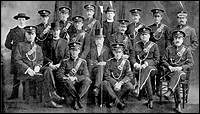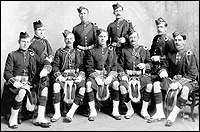|


|

|

Paramilitary Groups
Between 1892 and 1914, several local churches sponsored uniformed youth
organizations that combined religious instruction and military training. Their separate existence is a
reflection of sectarian divisions prevalent at the time. The first to appear was the Church Lads’
Brigade (CLB), formed in 1892 by the Church of England and based on an English organization.
Church Lads’ Brigade, ca. 1910.
Photograph by G. H. Parsons.
Courtesy of the Provincial Archives of Newfoundland and Labrador (PANL NA-6066), St. John’s,
Newfoundland.
 (42 Kb)
(42 Kb)
|
 |

|
The next 11 years witnessed the formation of three other organizations: the Catholic Cadet
Corps in 1896, the Methodist Guards in 1900 and the Presbyterian Newfoundland Highlanders in
1907. The primary concern of the church-sponsored groups was the moral and physical
development of their youth, based on the discipline and example of the British soldier.

|
 |
Officers of the Methodist Guards, ca. 1910.
Courtesy of the Provincial Archives of Newfoundland and Labrador (PANL B1-199), St. John’s,
Newfoundland.
 (48 Kb)
(48 Kb)
|
Newfoundland Highlanders in kilts, ca. 1910.
Courtesy of the Provincial Archives of Newfoundland and Labrador (PANL G-14-18), St. John’s,
Newfoundland.
 (40 Kb)
(40 Kb)
|
 |

|
The only non–denominational military organization in the colony was the Legion of Frontiersmen,
an Empire-wide commando-type established during the Boer War. By 1914, it operated two bases in
Newfoundland, one in St. Anthony and the other in St. John’s. With the exception of the
Frontiersmen and the CLB, the paramilitary groups were generally concentrated in St. John’s.
Most of the recruits were young men, eager to wear the uniform of one of the corps. The only exception
was the more professional non–denominational Legion of Frontiersmen. These paramilitary groups, a far cry from
the professional soldiers of the British Army, imbued a generation of Newfoundlanders with military values
and a strong sense of public service. Thus, while unprepared for the kind of conflict the Great
War would come to represent, Newfoundlanders were not entirely unfamiliar with military affairs. It would be these
same paramilitary brigades who would fill the ranks of the First Five Hundred recruits for the regiment in 1914.
By the end of August 1914, these brigades accounted for the majority of the more than 700
volunteers for the regiment and Royal Naval Reserve. In December 1914, the Reverend Levi Curtis
said, once the call for recruits went out, that
430 lads belonging to the Brigades entered the ranks—a magnificent response.
This was the supreme test as to the value of Brigades, and demonstrated beyond
all contradictions their great value to the country and Empire . . . In this alone we
have abundant returns for all the investment in these organizations (Curtis 11).
The officers of the First Newfoundland Regiment were drawn largely from the ranks of
these paramilitary groups. The CLB continued to play a leading role in training of recruits for the
Second Contingent.

|

|
 |